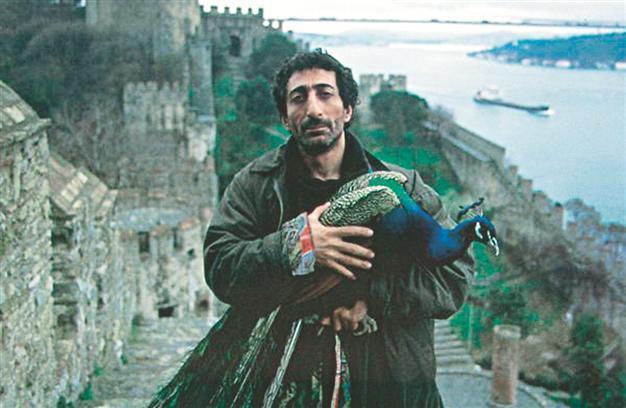Istanbul the home for both comedies and melodramas
Emrah Güler ANKARA

The fish-out-of-water story never gets old for Turkish cinema. The hapless villager trying to make sense of the big city, his big dreams and even bigger disappointments in this new city have been the subject of many a Turkish film, albeit in different styles and in different genres. This big city has almost always been Istanbul, a reflection of reality with its appeal to millions in rural Turkey throughout the decades.
Whether it’s the romanticized version of the 1960s and 1970s Yeşilçam melodramas or the comedies of the 1980s, the darker dramas of the 1990s or the crude comedies and socially realistic festival favorites of the new millennium, Istanbul has been a major player in Turkish cinema, a welcoming and crushing presence all at once.
This week’s “Yav He He,” directed by Volkan Özgümüş, tells the story of two villagers coming to Istanbul, as it happens, to sell their sheep so they can buy medicine for their dying grandmother. The film plays on the mishaps of the two as they try to find their way in this grand, strange, yet beautiful city. Sabri and Medeni, the leading characters, are not the first villagers to have their lives turned upside down in the hopes of something better.
Academic Mehmet Öztürk cites late director Atıf Yılmaz’s “Suçlu” (Criminal) of 1959 as the first film to portray “the new urbanization of Istanbul” by including scrappy shantytowns. In the following two decades, Istanbul would come to play a pivotal role in almost all of the Yeşilçam melodramas, as the ultimate promise for better lives and better futures.
The green hills of the Bosphorus served as the ideal backdrop to stories of love, heartbreak, hope and disappointment. As more people flocked to Istanbul, again both on and off screen, shantytowns began taking their places next to the dreamy mansions overlooking the Bosphorus. Istanbul became the Turkish dream where the rural Turkey watched in awe.
Haydarpaşa Train Station was the ultimate symbol of migration, always the final stop in a long train ride from stilted lives to brighter futures. The fish-out-of-water story always began with the character carrying her suitcase, looking scared and dumbstruck in Haydarpaşa. Soon, two faces of Istanbul were juxtaposed next to one another, the affluent and the poor, like 1966’s classic “Ah Güzel İstanbul” (Oh Beautiful İstanbul), again directed by Yılmaz.
Lucky loser identified with Kemal SunalWhile the melodramas lost their appeal in 1970s, Istanbul never lost its popularity in the storylines. The naïve and lucky migrant in Istanbul became the go-to character in Turkish cinema. Some characters like Feridun Karakaya’s Cilalı İbo (Polished İbo) and Sadri Alışık’s Turist Ömer (Tourist Ömer) became so popular, they repeated their roles in a series of films.
But it was the late actor Kemal Sunal, who became the ultimate symbol of the fish-out-of-water. With his slow wit, wide grin, and never-ending awe with what the city would bring him next, he played the same character over and over for decades. Turkish audiences never tired of Sunal, loving this lucky loser who always made light of being lost in the big city. He became the King of the Superintendents, the King of the Street Cleaners, and the King of the Guards.
When Turkey created its own nouveau riche after the 1980s with its money-making policies, Sunal’s characters became the poster boy for the post-’80s Istanbul dream. The titles of some of his films clearly mirrored the social change in Turkey, “Çarıklı Milyoner” (Millionaire with Mocassins), “Katma Değer Şaban” (Value-Added Şaban) and “Sosyete Şaban” (High Society Şaban).
The 1990s cinema reflected a bleaker, darker Istanbul, devoid of hope for a better future, with migrants stuck in their personal hells in shanty towns. Director Zeki Demirkubuz’s classics of late 1990s and early 2000s, like “Masumiyet” (Innocence), “Üçüncü Sayfa” (Third Page) or “İtiraf” (Confession), headlined a series of movies that portrayed these lost lives in a lost city.
The last decade has seen a mixture of comedies in the familiar tradition of the naïve villagers in Istanbul, and darker stories of single mothers, honor killings and small-time mafia in the underbellies of Istanbul. The green across the shores of the Bosphorus, on and off screen, seems to have left its place to towering buildings, a domineering green and unhappy people. Here’s hoping for the return of an Istanbul of half a century ago.
 The fish-out-of-water story never gets old for Turkish cinema. The hapless villager trying to make sense of the big city, his big dreams and even bigger disappointments in this new city have been the subject of many a Turkish film, albeit in different styles and in different genres. This big city has almost always been Istanbul, a reflection of reality with its appeal to millions in rural Turkey throughout the decades.
The fish-out-of-water story never gets old for Turkish cinema. The hapless villager trying to make sense of the big city, his big dreams and even bigger disappointments in this new city have been the subject of many a Turkish film, albeit in different styles and in different genres. This big city has almost always been Istanbul, a reflection of reality with its appeal to millions in rural Turkey throughout the decades.